By Ben Dooley, Makiko Inoue and Eimi Yamamitsu
Naganuma, Japan: The time was 1.30 am, and Hiroshi Ogawa was trying to decide whether he should run from the biggest typhoon to hit Japan in decades.
His home stood near the Chikuma River in Nagano prefecture, separated from the rising waters by a levee.
"I had confidence in the levee," Ogawa, 68, said. "I had faith that it was built to withstand a 100-year flood, so it should be OK."
It was not. A little over an hour later, the levee burst, submerging his home and sweeping away everything in it. He barely escaped: Minutes before, he had driven to higher ground after being warned by volunteer firefighters to flee.
The levee, in an area north-west of Tokyo, was one of at least 55 breached as Typhoon Hagibis dumped record-breaking rains on Japan last weekend, with more than 70 people dying in the storm and floodwaters hitting more than 10,000 homes.
Japan, a nation grimly accustomed to natural disasters, has invested many billions of dollars in a world-class infrastructure meant to soften nature's wrath. But with the flooding in areas across central and northern Japan in recent days, the country has been forced to examine more deeply the assumptions that underpin its flood control system.
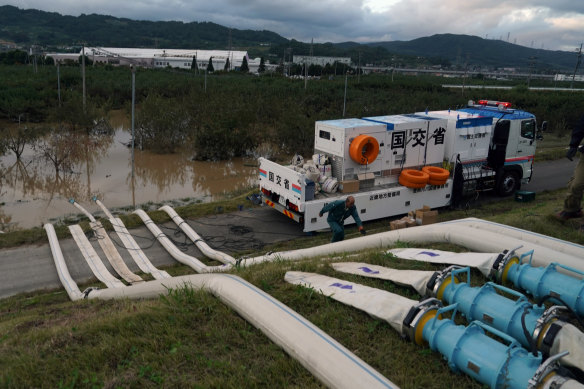
Water pumps drain flooding from a breached levee in Naganuma, near the city of Nagano in Japan.Credit: New York Times
That is raising a difficult question, for Japan and for the world: Can even the costliest systems be future-proofed in an age of storms made more powerful by climate change?
Yasuo Nihei, a professor of river engineering at the Tokyo University of Science, said that in places around Japan, "we're observing rain of a strength that we have never experienced. When we look at the costs, I think it's clear that flood control programs need to be accelerated."
Even so, he said, "realistically, there will be rains you can't defend against".
That has not always been the view of the Japanese government. For centuries, it has seen disaster management as a problem to be solved by engineering.
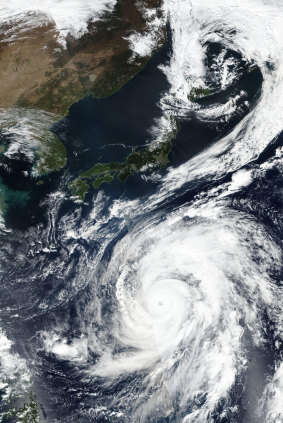
Typhoon Hagibis approaching the south-east coast of Japan on October 9.Credit: NASA via New York Times
After a devastating typhoon killed more than 1200 people in the late 1950s, Japan embarked on a series of public works projects aimed at taming its many rivers. Levees and dams sprang up on nearly every river, and civil engineers sheathed long stretches of riverbeds in concrete.
While the projects have saved countless lives, they are insufficient to meet the challenge of increasingly extreme weather patterns, said Shiro Maeno, a professor of hydraulic engineering at Okayama University.
"In the current state, it wouldn't be strange for a flood to happen anytime, anywhere," Maeno said. "Things we never could have considered have started happening in the last few years."
The heavy investment in infrastructure has not come without a cost. The spending has helped send Japan's national debt to record highs, as the country has approved many projects that turned out to be minimally effective or, at worst, damaging to the environment.
The Japanese government has also used infrastructure spending to stimulate an economy that was stagnant for decades. Critics note that some of the projects are little more than a tool for enriching construction companies, with part of the proceeds being returned to local politicians in the form of campaign donations.
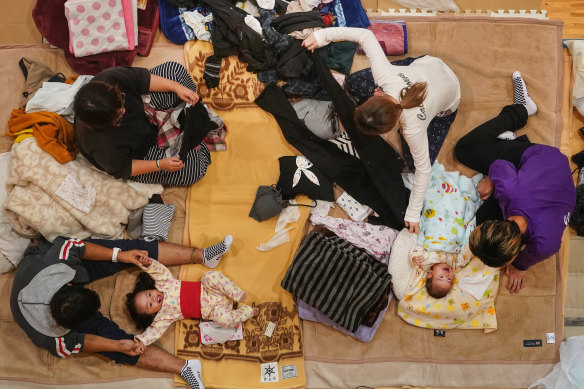
Evacuation, as seen here in Koriyama, Japan, could be the best response to increasingly frequent natural disasters such as Typhoon Hagibis.Credit: New York Times
Whatever the motivation for the spending, engineers are warning that as storms grow in intensity, the government faces diminishing returns as it contemplates raising levees or digging new drainage tunnels. But in the wake of the typhoon, the burning question among Japanese politicians is whether the country should be investing even more.
Daniel Aldrich, a professor of political science at Northeastern University in Boston who studies disaster management, said that huge engineering projects had often provided a false sense of security, leading people to avoid what can be a more effective response: evacuation.
"Why would you possibly leave when you have this system set up to protect you?" he said. "Why go anywhere? It's a moral hazard when you believe the systems in place will protect you more than the process of fleeing, which is of course what we really want."
In 2017, the national government passed a revision to the country's flood and river controls laws aimed at decreasing the mounting economic damage from extreme weather and bringing the number of deaths caused by the failure to evacuate down to zero - a challenge made greater by the country's rapidly ageing population.
The changes have forced local governments to revise how they prepare for disasters. Instead of planning for 100-year storms, they are now thinking about more destructive once-in-1000-year disasters.
Last summer, Nagano city, which administers Naganuma, where Ogawa's house was inundated, redrew its flood maps. The old maps, drawn up in 2006, imagined a situation in which Naganuma could be covered with up to five metres of floodwater.
But planners now imagine a much worse scenario: 40 centimetres of rain over two days, resulting in more than a dozen levee breaches and leaving Naganuma drowning under 20 metres of water.
Even that might not be pessimistic enough. Last weekend, when Typhoon Hagibis hit Hakone, a mountain resort town south of Tokyo, 100 centimetres of rain fell in 48 hours.
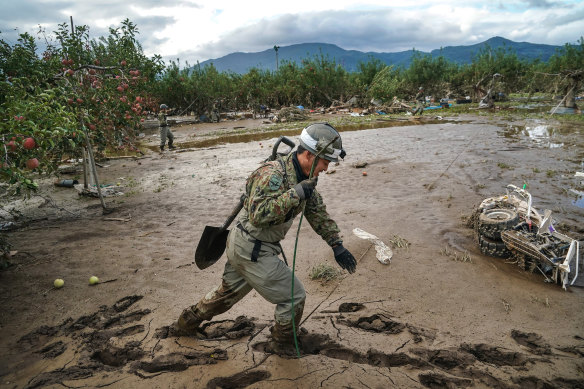
Rescue personnel walk over a sea of mud near an orchard in Nagano, Japan.Credit: New York Times
In a city like Tokyo with millions of people, the planners' 1000-year projection might justify spending billions on high-tech flood prevention systems.
But in a rural area like Naganuma, the government needs to make tough choices, said Hiroki Okamoto, a local official in charge of managing the Chikuma River.
"We have to move forward with the understanding that no matter what's installed, there will be a flood that it can't defend against," Okamoto said. The government needs to shift its focus to "doing public relations work so that people will evacuate" during floods, he said, adding, "It's hard to get them to run."
That thinking goes against the mainstream, said Aldrich, the professor at Northeastern University.
"As societies think about how to deal with global climate change, many of them are starting to switch to an engineering mindset, when they should be placing more emphasis on so-called soft measures like encouraging neighbours to help each other evacuate ahead of a disaster," he said.
"A lot of societies in North America or Singapore or Japan have become fixated on the idea that we'll engineer our way out of this problem," he added. "We'll build floating buildings or better sensors, which is all well and good, but what do you do if your cellphone doesn't work? Or you don't have access to electricity?"
In Naganuma, where rescuers have so far recovered two bodies from the area near the levee breach, it was those "soft measures" that saved people like Ogawa and the 400 others who evacuated the area.
Mitsuyoshi Oguchi, a local handyman, said that every year the entire town - which has a long history of flooding - participated in evacuation drills. At a temple close to the river, a wooden pole more than three metres tall records the area's major floods. Near the top, the year 1742 is written in thick, black Chinese characters.
On Saturday evening, as the waters rose, city officials called residents and begged them to leave. Volunteers, including Ogawa's wife, Kyoko, went door to door, helping their elderly neighbours make the trip to an evacuation centre.
Still, few residents expected that a typhoon would break the levee in their lifetimes.
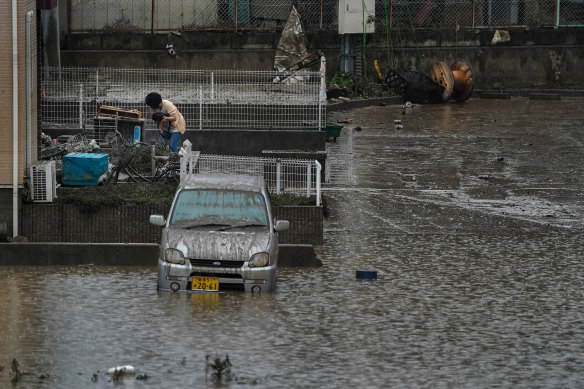
A woman cleans out her home in a still-flooded area in Koriyama, Japan.Credit: New York Times
On Wednesday, construction crews raced to repair the gap in the Chikuma levee. Cranes lowered giant concrete blocks into the breach, then covered them with dirt. On the far side of the levee, where low fields run to the riverbank, hundreds of apple trees were covered to their crowns in muddy water.
Here and there, residents took the first steps toward recovery, shovelling out their homes and dragging away waterlogged furniture.
"We're lucky," Ogawa's daughter Natsumi said in front of her parents' stately home, one of many houses built with money from the orchards. "All of our furniture got washed away, so there's not much to clean up."
Ogawa himself was not quite so sanguine. His home and his apple business will recover, he said, but he's not sure he ever will.
"Even if the levee is fixed, every time there's a heavy rain or a typhoon, my chest is going to tighten," he said. "I want to move to a place where my family can live without worrying."
The New York Times